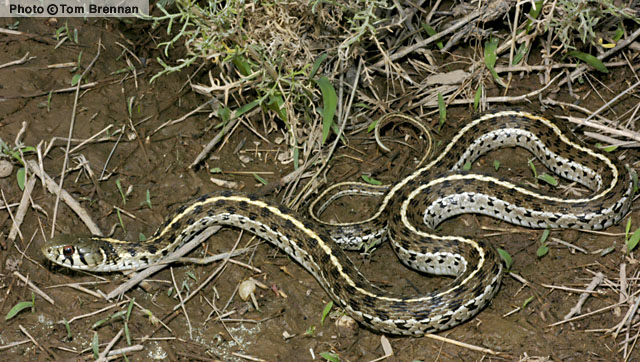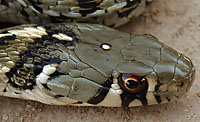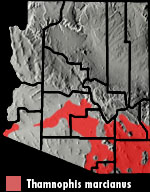Online Field Guide to The Reptiles and Amphibians of Arizona



Cochise County, AZ
 Cochise Co., AZ |
| CHECKERED GARTERSNAKE Thamnophis marcianus |
Non-Venomous
|
| DESCRIPTION: A medium-sized (up to 1,088 mm or 43″ in total length) light olive-green, tan, or yellow-green snake with a pale stripe down the middle of the back. An additional light stripe runs along each lower side on the third scale row (counting up from the belly). The dark areas between the stripes are marked by rows of dark, alternating, rectangular blotches that give the snake a checkerboard appearance. the dark blotches often intrude into the mid-dorsal stripe. The head is plain olive gray and the neck is marked with two large, dark-edged, olive gray blotches. A white crescent shape extends up from the neck onto each side of the head just in front of the neck blotches. Each eye is sandwiched between two vertical, white bars with black edges. The underside is light cream, yellow, or gray. The pupils are round and the dorsal scales are keeled.
DISTRIBUTION: This snake is found across the valleys of southeastern Arizona. It also follows agriculture and riparian corridors into portions of south central Arizona around Casa Grande, Phoenix, Fort McDowell, Buckeye, and Gila Bend. A population that might be isolated occurs in agricultural areas south of Yuma along the Colorado River. In Arizona it ranges in elevation from sea level to over 5,000′. HABITAT: Semidesert Grassland, Chihuahuan Desertscrub, Sonoran Desertscrub, and the lower reaches of Madrean Evergreen Woodland communities are home to this snake. It is a lowland species that inhabits valleys, flatlands, and broad, low, riparian corridors. Although it is not restricted to areas with permanent water it seems to be most abundant in the vicinity of ponds, moist grasslands, tanks, drainages, irrigated areas, and rivers.BEHAVIOR: It can be active at any time of night or day when conditions are favorable. It hibernates during the cold months of late fall and winter. When captured it often expels a foul smelling musk from the cloaca.DIET: This dietary generalist actively forages for frogs, toads, tadpoles, lizards, salamanders, snakes, small mammals, fish, and insects.REPRODUCTION: Up to 35 young are born in spring or summer. By Thomas C. Brennan Bartlett. 2000. Snakes of North America: WesternRegion. Gulf Publishing Co. Houston, TX Brennan, T. C., and A. T. Holycross. 2006. A Field Guide to Amphibians and Reptiles in Arizona. Arizona Game and Fish Department. Phoenix, AZ Brennan, T. C., and A. T. Holycross. 2005. A Field Guide to Amphibians and Reptiles of Maricopa County. Arizona Game and Fish Department. Phoenix, AZ Degenhardt, W. G., Painter, C. W., and Price, A. H.. 1996. Amphibians and Reptiles of New Mexico. University of New Mexico Press. Albuquerque. Fowlie. 1965. The Snakes of Arizona. Azul Quinta Press, Fallbrook, CaliforniaStebbins. 1985. Western Reptiles and Amphibians. Houghton Mifflin. New York, |
|
Visit Partners in Amphibian and Reptile Conservation:


HOME
Copyright © 2023, Arizona Game and Fish Department. All rights reserved.
If you make use of the textual contents of this site in reports, publications, etc. please cite and credit the author(s) and photographer(s). All photos on this website are copyrighted. However, those found in the species account section may be used for any noncommercial scientific, educational, or conservation purposes provided that photographs are not altered and continue to bear the copyright symbol and name of the photographer. Please contact the photographer regarding commercial use of copyrighted photographs.










